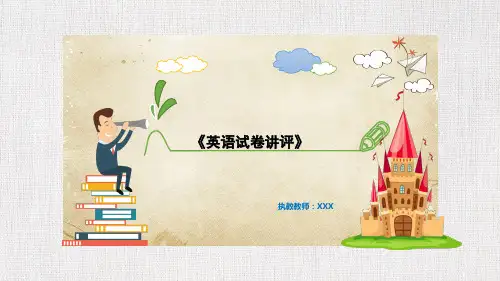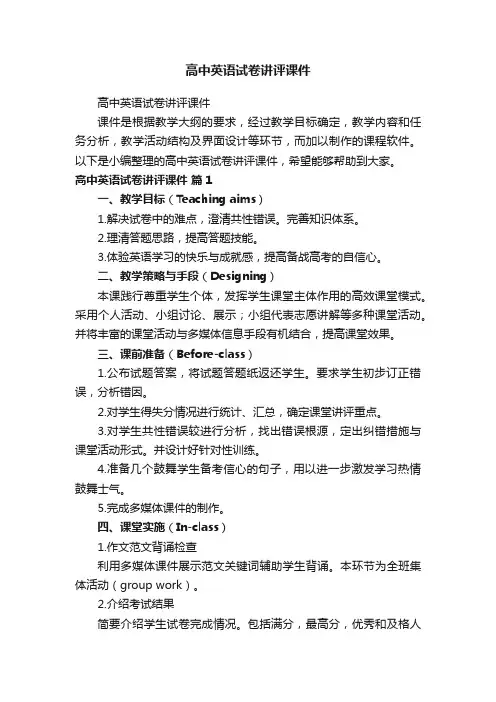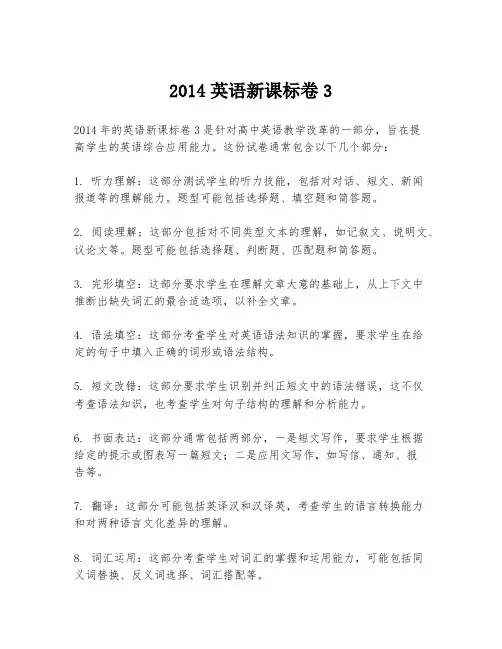2014高中英语试卷讲评课课件--3
- 格式:ppt
- 大小:699.50 KB
- 文档页数:10




高三年级月考试卷(英语)使用时间:2014年12月27日测试时间: 120分钟总分: 150 分第I卷第一部分:听力(略)第二部分:阅读理解(共两节,满分60分)第一节(共15小题,每小题3分,满分45分)阅读下列短文,从每题所给的四个选项(A、B、C和D)中,选出最佳选项,并在答题卡上将该项涂黑。
AHorse Riding LessonsPrice: Private lesson—£30 per hour; Group Lesson—£25 per hour (3 or more riders)Holiday Club—£ 50 per dayDuration: 1 hour or full day club for young ridersLocation: Looe PL14 4REAge Restrictions: 5 years or overNotes: In the interests of your safety, please wear smooth-soled shoes with low heels(后跟). Please note that all riders will be advised to wear hats before starting a lesson.Polmartin Riding is close to Looe and Liskeard. Horse riding and lessons are available all year, whatever the weather.Situated in around sixty acres of Cornish landscape, our training farm offers stunning 360-degree views of the sea and farmland. Our treks(长途跋涉) wind through fields, lakes, streams, woods and hillsides, resulting in a unique and wonderful ride, in safety and without the worry of meeting any traffic.If you prefer to learn to ride or improve your skills, our riding lessons are varied and are matched to your needs and ability. You can be assured that all lessons are of the highest standards. We are able to train riders in a variety of disciplines according to the formal BHS standards.Our Holiday Clubs are for the young riders who really want to learn about horses, not just riding. They will learn how to feed and clean horses, and how to help others by leading horses. They will have a group lesson of an hour in the morning or in the afternoon, a ride out on the farm. Children planning for the day must be at least 8 years old and should also bring a packed lunch.1. If you attend the private lesson for five hours, you will pay______.A. £100.B. £150.C. £200.D. £250.2. The children attending Holiday Clubs have to_______.A. buy a hatB. bring lunchC. lead a horseD. feed a horse3. Which of the following statements is TRUE?A. The horse riding training runs only in spring and summer.B. The Holiday Clubs provide more varied lessons for the learners.C. The riding lessons provided by the training are varied but amateur.D. You should choose a proper training time to avoid the traffic congestion.BIceland is experiencing a book boom(突然风靡的时期).There is a phrase in Icelandic, “ad ganga med bok I maganum”, meaning everyone gives birth to a book. Literally, everyone “has a book in their stomach”. One in 10 Icelanders will publish one.“Does it get rather competitive?” I ask the young novelist, Kristin Eirikskdottir. “Yes, especially as I live with my mother and partner, who are also full-time writers. But we try to publish in alternate years so we do not compete too much.”“Writers are respected here,” Agla Magnusdottir tells me. “They live well. S ome even get a salary.” Magnusdottir is head of the new Icelandic Literature Centre, which offers state support for literature and its translation. “They write everything — modern sagas (长篇小说), poetry, children’s books, literary fiction —but the biggest bo om is in crime writing,” she says.So what has led to this extraordinary book boom? I would say it is due to a crop of good writers, telling interesting tales with elegant economy and fantastic characters.Iceland’s black lava (火山岩)riverbeds, its steaming, bubbling earth, with its high volcanoes and great streams also make it the perfect setting for stories. Solvi Bjorn Siggurdsson, an Icelandic novelist, says writers owe a lot to the past. “We are a nation of storytellers. When it was dark and cold we had nothing else to do,” he says. “Thanks to the poetic works and medieval (中世纪的)sagas, we have always been surrounded by stories.”Siggurdsson shows respect to Iceland’s Nobel Literature winner, Halldor Laxness, whose books are sold in petrol stations and tourist centres across the island. Locals name their cats after Laxness and pay visits to his home. “When Laxness won the Nobel Prize in 1955 he put modern Icelandic literature on the map,” Siggurdsson tells me. “He gave us confidence to write.”4. The phra se in Icelandic “ad ganga med bok I maganum” in Paragraph 2 suggests that ______.A. Icelanders love readingB. Icelanders love writingC. there are a lot of good books in IcelandD. it’s competitive to publish a book in Iceland5. What kind of book is the most popular in Iceland?A. Poetry.B. Medieval sagas.C. Crime novels.D. Children’s stories.6. What can we learn from the last paragraph?A. Halldor Laxness is the teacher of Siggurdsson.B. Halldor Laxness is greatly respected in Iceland.C. Writers in Iceland benefit from its literary tradition.D. Siggurdsson won the Nobel Prize in Literature in 1955.7. According to the passage, Iceland _______.A. has more writers than any other country in the worldB. possesses some factors to be the perfect setting for storiesC. publishes more books than any other country in the worldD. advises people to publish books to increase their incomeCLast weekend I moved into a share house. It will come as a surprise to anyone that I’m no longer a lively, young 20-something. According to my own rules, this is not how things were supposed to be at 40. I should be organising schedules for childcare and family holidays, not working out a list assigning whose turn it is to clean the toilet. But I am. And I’m OK with it.A recent article from another 40-something who moved back in with his family after losing his job indicates how routine people can be. Comments suggested he should grow up and stop depending on his parents. Even I had a short moment thinking he should get organized by now. But why? Why should a 41-year-old have to follow the routine lifestyle?Despite the phone calls I make to keep in touch, being alone at home can be mentally challenging. So why then would I deny myself the option of having someone to talk to in the evening, to laugh with or to cook food for, simply because I think I’m too old for that kind of nonsense?Please don’t assume I am Peter Pan (天真的成年人). I love being alone and need quiet time. But while I’m busy at a new job, sometimes it’s difficult to keep a sunny mood when you head home alone with no one to ask how your day was or if you’d like some cake.Perhaps it’s not us single 40-somethings that need to grow up, but the routine views of others that need to be altered. Society is changing rapidly. Jobs aren’t for life, so we need to be more flexible. Rather than give judgment, why not add it to the growing list of alternatives to the “house, two kids anda dog” nuclear family.8. It can be learned from Paragraph 1 that the author .A. is as energetic as 20-somethingsB. opposes cleaning the toilet in turn between roommates.C. is changing her rules about how 40-somethings should liveD. doesn’t like organizing sc hedules for childcare and family holidays9. What can be inferred from Paragraph 2?A. The author thought highly of the critical people.B. The author had doubts about the 41-year-old’s choice.C. The author still thought the man ought to be independent.D. The author showed a negative attitude to the comments.10. We can learn from Paragraph 3 and 4 that the author .A. dislikes being aloneB. can’t bear the feeling of lonelinessC. is really too old to have a young perso ns’ gameD. has denied the option of having someone as company11. What does the author imply in the last paragraph?A. People don’t live to work.B. People today enjoy a long life.C. The old rules won’t work one day.D. Nuclear families will disappear gradually.DElephants are known to be highly social and intelligent. Now there is evidence that they will show something that looks very much like a group hug when a fellow elephant is in despression.Joshua Plotnik, who leads a conservation and education group called Think Elephants, and teaches conservation at Mahidol University in Thailand, studied elephants at a park in Chiang Rai Province in Thailand, to look for consolation(慰藉)behavior.As explained by Frans de Waal, Dr. Plotnik’s Ph.D. adviser at Emory University, consolation behavior involves bystanders’ responding to an animal that is in emotional depression. The depression may be caused by a conflict with another member of the group.“We’re pretty confident it’s relatively rare in animals,” Dr. Plotnik said in an interview. He said there was good evidence for the behavior in apes, wolves and some birds. And he said there had been some reports of such behavior in dolphins and elephants.Elephants clearly have strong emotional connections to other elephants and are highly intelligent, so it made sense to think that they might console one another. To find out, Dr. Plotnik observed 26 elephants in six groups at a managed park.When one elephant was disturbed, Dr. Plotnik said, other elephants —bystanders —gathered around. They made soft sounds and touched the depressed elephant, head to mouth with their long trunk(象鼻), which are comforting gestures, for elephants.Dr. Plotnik said that since he couldn’t always observe the original source of the depression, he couldn’t say that the behavior met the real meaning of consolation, as it was not clear whether it followed conflict. The elephants might have been scared by a person, dog, or, in some cases, a noise that humans couldn’t hear.But, he said, in every other way the elephant behavior showed that they were acting to comfort elephants that were upset.12. What would other elephants do when one elephant was in depression?A. They would stand by to watch.B. They would make comforting gestures.C. They would gather around to defend it.D. They would make sounds to cheer it up.13. Joshua Plotnik is sure that __________.A. dolphins too have consolation behaviorB. most animals have consolation behaviorC. consolation behavior only exists in a few animal speciesD. consolation behavior exist in highly intelligent animals14. What Dr. Plotnik says in the last paragraph suggests that __________.A. he is sure of the finding of his studyB. he has found a new meaning of consolationC. he needs further evidence to conclude his studyD. it’s impossible to find the source of elephants’ depression15. Which of the following best gives the main idea of the passage?A. Elephants have emotions.B. Elephants can get upset.C. Elephants are highly social and intelligent.D. Elephants give a comforting trunk.第二节(共5小题;每小题3分,满分15 分)根据短文内容,从短文后的选项中选出能填入空白处的最佳选项。

高中英语试卷讲评课件高中英语试卷讲评课件课件是根据教学大纲的要求,经过教学目标确定,教学内容和任务分析,教学活动结构及界面设计等环节,而加以制作的课程软件。
以下是小编整理的高中英语试卷讲评课件,希望能够帮助到大家。
高中英语试卷讲评课件篇1一、教学目标(Teaching aims)1.解决试卷中的难点,澄清共性错误。
完善知识体系。
2.理清答题思路,提高答题技能。
3.体验英语学习的快乐与成就感,提高备战高考的自信心。
二、教学策略与手段(Designing)本课践行尊重学生个体,发挥学生课堂主体作用的高效课堂模式。
采用个人活动、小组讨论、展示;小组代表志愿讲解等多种课堂活动。
并将丰富的课堂活动与多媒体信息手段有机结合,提高课堂效果。
三、课前准备(Before-class)1.公布试题答案,将试题答题纸返还学生。
要求学生初步订正错误,分析错因。
2.对学生得失分情况进行统计、汇总,确定课堂讲评重点。
3.对学生共性错误较进行分析,找出错误根源,定出纠错措施与课堂活动形式。
并设计好针对性训练。
4.准备几个鼓舞学生备考信心的句子,用以进一步激发学习热情鼓舞士气。
5.完成多媒体课件的制作。
四、课堂实施(In-class)1.作文范文背诵检查利用多媒体课件展示范文关键词辅助学生背诵。
本环节为全班集体活动(group work)。
2.介绍考试结果简要介绍学生试卷完成情况。
包括满分,最高分,优秀和及格人数。
3.明确教学目标与课堂内容(教师做简要说明)让学生明确这节课要做些什么,需要达成怎样的目标。
所有课堂设计与活动都是实现三维学习目标的措施与手段。
4.试题讲解A.单项选择(individual work)。
学生独立思考解决单项选择中正答率为70%以下的题目(单选1.3.6.10)。
课件展示正答率、干扰项与考点。
独立思考2分钟后学生volunteer讲解题目。
有疑问的同学随时站起来质疑。
教师进一步点拨、总结。
然后当堂检测掌握情况,做巩固提升题(选取高考真题及2014高考预测)。



![高中英语试卷讲评课课件_[1]](https://uimg.taocdn.com/626c69ebfab069dc50220116.webp)

2014英语新课标卷3
2014年的英语新课标卷3是针对高中英语教学改革的一部分,旨在提
高学生的英语综合应用能力。
这份试卷通常包含以下几个部分:
1. 听力理解:这部分测试学生的听力技能,包括对对话、短文、新闻
报道等的理解能力。
题型可能包括选择题、填空题和简答题。
2. 阅读理解:这部分包括对不同类型文本的理解,如记叙文、说明文、议论文等。
题型可能包括选择题、判断题、匹配题和简答题。
3. 完形填空:这部分要求学生在理解文章大意的基础上,从上下文中
推断出缺失词汇的最合适选项,以补全文章。
4. 语法填空:这部分考查学生对英语语法知识的掌握,要求学生在给
定的句子中填入正确的词形或语法结构。
5. 短文改错:这部分要求学生识别并纠正短文中的语法错误,这不仅
考查语法知识,也考查学生对句子结构的理解和分析能力。
6. 书面表达:这部分通常包括两部分,一是短文写作,要求学生根据
给定的提示或图表写一篇短文;二是应用文写作,如写信、通知、报
告等。
7. 翻译:这部分可能包括英译汉和汉译英,考查学生的语言转换能力
和对两种语言文化差异的理解。
8. 词汇运用:这部分考查学生对词汇的掌握和运用能力,可能包括同
义词替换、反义词选择、词汇搭配等。
9. 口语表达(如果包含):虽然不是所有试卷都包含口语部分,但一
些地区可能会有口语测试,以考查学生的口语交流能力。
试卷的设计旨在全面考查学生的英语语言能力,包括听、说、读、写、译等方面,以适应新课标对英语教学的要求。
